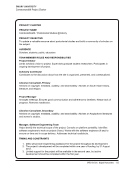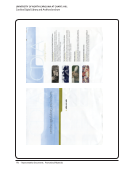SPEC Kit 326: Digital Humanities · 51
Sagittarius Project, an initiative to digitize literary resources for teaching and learning for use by Canadian high schools.
Archives partnered with PhD students in the History Department on the Portuguese-Canadian History Project and with
PhD students from the Music Department on the Mariposa Digital Archives Project.
Digital Humanities Initiative. The dean was a founding partner and encouraged broader collaboration by librarians.
English department worked together to provide funding.
Grants writing with departments.
Here are some examples: Library &Cornell Society for the Humanities: http://goldsen.library.cornell.edu/. Collaboration
with Arts &Sciences: https://confluence.cornell.edu/display/grantsas/Grants+Program+for+Digital+Collections+in+
Arts+and+Sciences. Collaboration with the University Press: http://signale.cornell.edu/, https://confluence.cornell.edu/
display/grantsas/Grants+Program+for+Digital+Collections+in+Arts+and+Sciences.
Humanities Computing and/or Campus IT Scholarly Computing units. We have an informal understanding about
what types of projects each unit should be involved in so often projects come to us through referral from another IT
department or vice versa. The library tends to focus more on the collections involved, the archiving, and the metadata
components of a project, whereas other campus IT units might focus on the classroom use of what is being developed,
the staffing to create the resource, and multi-media support.
Hyperstudio, consulting and project concept development.
I don’t think there have been significant formal partnerships. In some cases, however, librarians have worked with
faculty members in academic departments to identify materials, digitize them, and create web pages and finding aids to
promote their use.
IDAH, University IT Services (UITS).
Instructional Media Services, a division of University IT, helps with checkout of hardware other divisions of UIT have
been helpful in planning and setting up some services as well as helping faculty understand the full spectrum of
multimedia production services that are available on campus. We are currently collaborating with the Geography
Department to develop our geospatial information services.
Modern Language and Cultures Department: partnered to house a film clips database to support language instruction.
Philosophy: partnered with a professor to create online visual mapping of seminal works in philosophy. English:
partnered with faculty members to teach digital humanities labs.
On an ad hoc project-by-project basis, for example history department structured a public history course syllabus around
production of a digital humanities project and had the students enrolled in the course do scanning and metadata
production for objects that went into both our ongoing repository and into their course-generated portal.
Our own Special Collections and Oral History Research Program. We also partner with several department on campus,
not necessarily humanities.
The Libraries have partnered with the Hall Center for the Humanities (a university research center) and with the College
of Liberal Arts and Sciences. The partnership was cultivated through an 18 month task force that recommended the
partnership to the current partners. The task force was chaired by a faculty member from the college and a librarian. The
Libraries and the Hall Center initiated the task force.
The library worked with the Graduate School of Library and Information Science (GSLIS) to develop and support the
public instance of a text-mining software, MONK. Researchers at GSLIS approached the library about supporting this
digital humanities tool for text mining, and an agreement was reached to transfer the tool from the researchers’ servers
Sagittarius Project, an initiative to digitize literary resources for teaching and learning for use by Canadian high schools.
Archives partnered with PhD students in the History Department on the Portuguese-Canadian History Project and with
PhD students from the Music Department on the Mariposa Digital Archives Project.
Digital Humanities Initiative. The dean was a founding partner and encouraged broader collaboration by librarians.
English department worked together to provide funding.
Grants writing with departments.
Here are some examples: Library &Cornell Society for the Humanities: http://goldsen.library.cornell.edu/. Collaboration
with Arts &Sciences: https://confluence.cornell.edu/display/grantsas/Grants+Program+for+Digital+Collections+in+
Arts+and+Sciences. Collaboration with the University Press: http://signale.cornell.edu/, https://confluence.cornell.edu/
display/grantsas/Grants+Program+for+Digital+Collections+in+Arts+and+Sciences.
Humanities Computing and/or Campus IT Scholarly Computing units. We have an informal understanding about
what types of projects each unit should be involved in so often projects come to us through referral from another IT
department or vice versa. The library tends to focus more on the collections involved, the archiving, and the metadata
components of a project, whereas other campus IT units might focus on the classroom use of what is being developed,
the staffing to create the resource, and multi-media support.
Hyperstudio, consulting and project concept development.
I don’t think there have been significant formal partnerships. In some cases, however, librarians have worked with
faculty members in academic departments to identify materials, digitize them, and create web pages and finding aids to
promote their use.
IDAH, University IT Services (UITS).
Instructional Media Services, a division of University IT, helps with checkout of hardware other divisions of UIT have
been helpful in planning and setting up some services as well as helping faculty understand the full spectrum of
multimedia production services that are available on campus. We are currently collaborating with the Geography
Department to develop our geospatial information services.
Modern Language and Cultures Department: partnered to house a film clips database to support language instruction.
Philosophy: partnered with a professor to create online visual mapping of seminal works in philosophy. English:
partnered with faculty members to teach digital humanities labs.
On an ad hoc project-by-project basis, for example history department structured a public history course syllabus around
production of a digital humanities project and had the students enrolled in the course do scanning and metadata
production for objects that went into both our ongoing repository and into their course-generated portal.
Our own Special Collections and Oral History Research Program. We also partner with several department on campus,
not necessarily humanities.
The Libraries have partnered with the Hall Center for the Humanities (a university research center) and with the College
of Liberal Arts and Sciences. The partnership was cultivated through an 18 month task force that recommended the
partnership to the current partners. The task force was chaired by a faculty member from the college and a librarian. The
Libraries and the Hall Center initiated the task force.
The library worked with the Graduate School of Library and Information Science (GSLIS) to develop and support the
public instance of a text-mining software, MONK. Researchers at GSLIS approached the library about supporting this
digital humanities tool for text mining, and an agreement was reached to transfer the tool from the researchers’ servers
































































































































































































